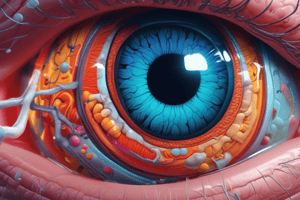Podcast
Questions and Answers
Which type of drugs affect neural communication utilizing opioids?
Which type of drugs affect neural communication utilizing opioids?
- Direct antagonists
- Indirect antagonists
- Indirect agonists
- Direct agonists (correct)
What is naloxone (Narcan) used for clinically?
What is naloxone (Narcan) used for clinically?
- To induce opiate intoxication
- To reverse opiate intoxication or overdose (correct)
- As an appetite stimulant
- As an analgesic
Which drug is known for producing analgesia, sedation, and appetite stimulation?
Which drug is known for producing analgesia, sedation, and appetite stimulation?
- Methadone
- Heroin
- Dronabinol (correct)
- Oxycodone
What is the active ingredient in marijuana responsible for its physiological effects?
What is the active ingredient in marijuana responsible for its physiological effects?
What do endocannabinoids act as in the body?
What do endocannabinoids act as in the body?
Which receptors are responsible for the physiological effects of the active ingredient in marijuana?
Which receptors are responsible for the physiological effects of the active ingredient in marijuana?
What is the most important factor that determines the rate at which a drug reaches sites of action within the brain?
What is the most important factor that determines the rate at which a drug reaches sites of action within the brain?
Why does an intravenous injection of heroin produce a more intense 'rush' compared to morphine?
Why does an intravenous injection of heroin produce a more intense 'rush' compared to morphine?
What is the blood-brain barrier primarily a barrier for?
What is the blood-brain barrier primarily a barrier for?
Which factor explains why heroin has a greater abuse potential than morphine?
Which factor explains why heroin has a greater abuse potential than morphine?
How does lipid solubility affect the distribution of molecules throughout the brain?
How does lipid solubility affect the distribution of molecules throughout the brain?
What is the best way to measure the effectiveness of a drug?
What is the best way to measure the effectiveness of a drug?
What is the relationship between a drug's affinity and the required concentration for effects?
What is the relationship between a drug's affinity and the required concentration for effects?
What is the difference between sensitization and tolerance to a drug?
What is the difference between sensitization and tolerance to a drug?
Which best describes the relationship between withdrawal symptoms and the effects of a drug?
Which best describes the relationship between withdrawal symptoms and the effects of a drug?
What is physical dependence on a drug?
What is physical dependence on a drug?
What is the definition of placebo?
What is the definition of placebo?
What is synthetic drugs' relationship with naturally occurring drugs?
What is synthetic drugs' relationship with naturally occurring drugs?
Explain the significance of endogenous opioids in neural communication.
Explain the significance of endogenous opioids in neural communication.
Discuss the differences between direct agonists and direct antagonists in the context of opiate receptors.
Discuss the differences between direct agonists and direct antagonists in the context of opiate receptors.
How do synthetic opiates like heroin, methadone, and oxycodone impact neural communication?
How do synthetic opiates like heroin, methadone, and oxycodone impact neural communication?
Explain the mechanism of action of naloxone (Narcan) in reversing opiate intoxication.
Explain the mechanism of action of naloxone (Narcan) in reversing opiate intoxication.
Describe the effects of THC (tetrahydrocannabinol) on neural communication and physiological responses.
Describe the effects of THC (tetrahydrocannabinol) on neural communication and physiological responses.
Discuss the significance of endocannabinoids in modulating the physiological effects of marijuana.
Discuss the significance of endocannabinoids in modulating the physiological effects of marijuana.
Explain the difference in lipid solubility between heroin and morphine and how it affects their abuse potential.
Explain the difference in lipid solubility between heroin and morphine and how it affects their abuse potential.
Discuss the role of lipid solubility in the distribution of molecules throughout the brain and its impact on drug effectiveness.
Discuss the role of lipid solubility in the distribution of molecules throughout the brain and its impact on drug effectiveness.
How do endogenous opioids contribute to the physiological effects of drugs on neural communication?
How do endogenous opioids contribute to the physiological effects of drugs on neural communication?
Explain the relationship between axoplasmic transport and the distribution of drugs in the brain.
Explain the relationship between axoplasmic transport and the distribution of drugs in the brain.
How do synthetic opiates differ from naturally occurring opiates in terms of their effects on the body?
How do synthetic opiates differ from naturally occurring opiates in terms of their effects on the body?
Discuss the physiological effects of the active ingredient in marijuana (THC) on the body and its mechanism of action.
Discuss the physiological effects of the active ingredient in marijuana (THC) on the body and its mechanism of action.
Explain the relationship between axoplasmic transport and the distribution of drugs within the brain.
Explain the relationship between axoplasmic transport and the distribution of drugs within the brain.
Describe the role of endogenous opioids in the body and their significance in pharmacology.
Describe the role of endogenous opioids in the body and their significance in pharmacology.
Explain the relationship between opiate receptors and the effects of drugs like heroin on the central nervous system.
Explain the relationship between opiate receptors and the effects of drugs like heroin on the central nervous system.
Discuss the development and impact of synthetic opiates in pharmacology compared to naturally occurring opiates.
Discuss the development and impact of synthetic opiates in pharmacology compared to naturally occurring opiates.
Explain how THC, the active ingredient in marijuana, produces its physiological effects in the body.
Explain how THC, the active ingredient in marijuana, produces its physiological effects in the body.
Discuss the concept of sensitization in relation to drug effects and how it differs from tolerance.
Discuss the concept of sensitization in relation to drug effects and how it differs from tolerance.
Flashcards are hidden until you start studying




